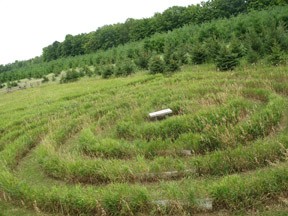Walking Labyrinths in Door County
- Share
- Tweet
- Pin
- Share
When Beth Coleman and her husband mowed the first labyrinth into a field at The Clearing, she planned to use it just for her contemplative gardening classes.
“When I had walked it I valued the experience so much… just that calming opportunity,” Coleman said. “I felt it had made an impact in my own life and I felt it could do that for other people.”
But it wasn’t just Coleman’s students who used the labyrinth. Other teachers began bringing their classes to the site, and The Clearing’s weekend visitors soon flocked to it. Last summer, The Clearing decided to make it permanent and set the landscape architecture intern to design a labyrinth with local stone.
“We’re kind of proud, obviously, that we have this nice thing here,” said Michael Schneider, executive director of The Clearing.

The labyrinth at Woodwalk Gallery. Photo by Allin Walker.
“I see students every week walking it. Some people go out early in the morning to walk it.”
Labyrinths are typically circular, and each one has a single path leading to a quiet space in the center. Walking one is a form of meditation, relaxation or pilgrimage, and doesn’t require anything but an open mind.
People often come to the labyrinth just to calm their minds, and some come to focus on a single question or issue in their lives and maybe get an answer out of the journey to and from the center.
“One thing that’s nice is to start out with an intention, and then just hold that intention as you walk,” said Kathy Navis, owner of Junction Center Yoga studio. There’s been a labyrinth open to the public at the studio since 2001.
The experience doesn’t have to be profound, Coleman said, but walkers should pay attention to what comes to mind while walking.
“It can be as monumental as people want it to be, or just as everyday as stopping your mind chatter and taking a walk,” Coleman said. “That’s what I like about it as a tool – it can be profound at times and other times it’s more of a day-to-day walking experience.”
Labyrinths aren’t mazes. The path follows a single route, so walkers don’t have to make any decisions on which way to go.
“The nice thing about a labyrinth is there’s no choice you have to make,” Coleman said. “Literally when you start, you follow the path and it takes you to the center. It’s not like a maze where you wonder if you’re at the right spot.”

The Clearing labyrinth. Photo by Carol Thompson.
Coleman’s only guideline for walking a labyrinth is to be receptive to the environment and open to sharing the labyrinth with fast or slow walkers, playful kids and meditative adults. Be conscious of other people, but don’t dwell on them.
“Maybe your lesson is ‘lighten up, have a little more fun and don’t take it so seriously’,” Coleman said.
The Clearing is home to just one of Door County’s labyrinths. The paths also show up at churches such as Hope Church in Sturgeon Bay, public spaces such as the Sister Bay/Liberty Grove library, art galleries such as Woodwalk Gallery and meditative spaces such as Junction Center Yoga Studio.
Woodwalk Gallery’s labyrinth is a simple spiraling path toward the middle, while The Clearing’s is a classic style where the path takes walkers in circuits around the circle until they reach the center.
“I took a volleyball net pole and put it in the middle of our field, tied a rope to it and then drove concentric circles with my riding lawn mower,” said Allin Walker, an owner of Woodwalk Gallery. “Then I hooked them together, so it’s a six-circle spiral into a nice bench in the middle that just happens to be the width of my riding lawn mower.”
Walker chose a spiral pattern because he finds the simple path to be more meditative and less intimidating. The gallery’s labyrinth is big, located in a two-acre field, and in the late summer and fall is surrounded by waist-tall grasses.
“There’s a real defined sense of the labyrinth whereas for much of the early summer you’re able to look out for a mile in every direction,” Walker said. “Now because of the height of the growing stuff you’re really focused in a different way… It changes with the seasons and that’s one of the nice things about it.”
Navis uses the labyrinth at Junction Center Yoga Studio for her Sunday morning zen meditation classes, and uses it as a tool to help students slow down and clear their minds.
“Basically, it’s just following the breath and paying attention to your surroundings,” Navis said. “With each turn of the labyrinth you see a new landscape.”

